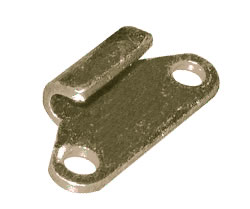
Latch strikes play an important role in the function of many access panels, doors and enclosures. They are used in conjunction with a latch to provide a means of opening and closing the aforementioned objects. After installing a latch and latch strike on an access panel, for instance, you’ll be able to open and close the panel.
What Is a Latch Strike?
A latch strike is a metal plate that provides a surface for a latching or locking mechanism to engage. It’s similar to a strike plate found on traditional doors. Most doors have a spring-loaded latch.
When you push a door closed, the latch will slide into the strike plate. When you pull open the door, the latch will slide out of the strike plate. Latch strikes serve the same purpose but are used with specialized latching or locking mechanisms rather than traditional door latches.
How Latch Strikes Work
Latch strikes work by providing a surface for a latching or locking mechanism to “strike.” Latches, of course, are installed on objects like access panels and doors. Latch strikes, on the other hand, are installed on the adjacent frame. With both of these components in place, you can open and close the respective access panel or door.
Pushing an access panel or door shut will allow the latch to catch the adjacent latch strike. As shown in the photo above, most latch strikes have a notch or hook. When you push the access panel or door shut, the latch will catch this raised notch or hook.
How to Choose a Latch Strike
Not all latch strikes are the same. You can find them in different materials. Some latch strikes are made of stainless steel or carbon steel, whereas others are made of aluminum or even brass. There are also plated latch strikes that feature a thin layer of a protective layer over the surface.
You should choose a latch strike that’s compatible with the latching or locking mechanism with which you intend to use it. Some latch strikes are designed for a specific type of latching or locking mechanism. They feature a specific size and overall design that only works with the respective latching or locking mechanism.
In Conclusion
You can’t ignore the importance of a latch strike when installing a latch. It will provide a fixed and stable surface for the latch to engage. Just remember to choose a latch strike that’s compatible with your latch type.



